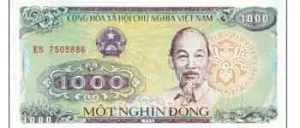

Notes in the polymer family are a bit more expensive to produce, but they also last longer than cotton notes. For example, gambling is a popular activity during Tet, the Vietnamese New Year, when people use cotton notes in the same way people would use change for “penny slots” in the United States.Īdding to their perceived (and actual) lower value is that cotton family notes are easily torn. Locals often collect these low-value cotton notes and later gamble with them during the holidays. The more common but still low-value 2,000 and 5,000 đồng notes are brown and blue, respectively. The 500 đồng red notes are slightly more popular, but even a small snack would likely cost at least a 1,000 đồng note, which is purple. You can’t buy anything with it alone, and for that reason, it’s quite rare to see one being used. (In current USD values, these range in value from less than a penny to $0.22).Ī 200 đồng note is bronze in color. You’ll rarely touch them because you simply can’t buy a lot with them.įive notes fall into this family: VND $200, VND $500, VND $1,000, VND $2,000, and VND $5,000. Notes in the cotton family are of low value. Vietnamese đồng banknotes come in two “families,” based on their material.Īll Vietnamese currency notes belong to one of two “families.” Banknotes of lesser value form the “cotton” family, and the others are the “polymer” family. There, you’ll see various national symbols, helping to distinguish between the notes. If you find it harder to differentiate between denominations, take a look at the backside of the banknotes. ” Uncle Ho is a national figure loved by some and vilified by others, but either way, his face is known by everyone in Vietnam. The face on these banknotes is that of Ho Chi Minh, popularly known as “ Uncle Ho. Yet, this isn’t true for the Vietnam đồng, every denomination of which focuses on the same historical figure. If you’re used to seeing bills like the United States dollar, New Zealand dollar, Thai baht, or Swiss franc, you’ll expect that every denomination of a national currency is marked by a different historical figure. That’s because they’re widely seen as collector’s items due to their incredibly low value. However, while the law says Vietnamese coins should be accepted as legal tender, some businesses, and even banks, may refuse them. Once travelers get over the new realities of being a millionaire and that not meaning much, the next big surprise usually comes when they go to make a purchase and realize that coins are rarely used in Vietnamese currency.ĭue to chronic inflation, the Vietnamese government has paused the production of coins at various points, last resuming production at the end of 2003 when they minted coins in 200, 500, 1,000, 2,000, and 5,000 đồng denominations. That is roughly the amount that a tourist would spend per day vacationing in Hanoi. While that’s technically true, having a million đồng does not make you wealthy.Īt the time of this writing, for example, 1 million đồng is worth about $43 U.S. For visitors to Vietnam, this often leads to the surprise that they’re “instant millionaires” upon converting foreign currency into đồng. Surpassed only by the Iranian Rial, the Vietnamese đồng is the second-lowest-valued currency in the world. You won’t be able to retire on 1 million Vietnamese đồng. In the mid-1980s, the currency was revalued, making every new đồng worth 10 old đồngs.ġ.The fall of Saigon in 1975 led to the currency in South Vietnam being converted to the liberation đồng.In the early 1950s, the South Vietnamese government adopted a different form of the national currency.


The đồng officially replaced the French Indochinese piastre in 1946, when it was introduced by the Viet Minh government (later known as the government of North Vietnam ).Further reading A brief history of Vietnamese currency


 0 kommentar(er)
0 kommentar(er)
